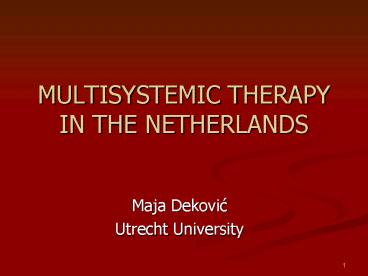MULTISYSTEMIC THERAPY IN THE NETHERLANDS - PowerPoint PPT Presentation
1 / 25
Title:
MULTISYSTEMIC THERAPY IN THE NETHERLANDS
Description:
treatment for youth who show serious, violent and chronic antisocial behavior ... S. van Arum (supervisor MST teams) J. Mulder (director De Waag) 7. AIMS ... – PowerPoint PPT presentation
Number of Views:55
Avg rating:3.0/5.0
Title: MULTISYSTEMIC THERAPY IN THE NETHERLANDS
1
MULTISYSTEMIC THERAPY IN THE NETHERLANDS
- Maja Dekovic
- Utrecht University
2
Multisystemic Therapy (MST)
- treatment for youth who show serious, violent and
chronic antisocial behavior (Henggeler et al.)
PROMISSING? WHY?
3
REASONS
- Theoretical foundation
- - theories about development and maintenance of
antisocial behavior - - theories of change
- Characteristics of treatment
- - address multiple causes of antisocial behavior
(broad focus) - - home- and community-based (ecological
validity) - - intensive
- - continuous monitoring of treatment adherence
4
EVIDENCE
- Empirical support from controlled clinical trials
in the USA - reduction of antisocial behavior and
prevention of recidivism in serious adolescent
offenders - (d.50, Curtic, Ronan, Borduin, 2004)
5
HOWEVER
- Difference between the USA and The Netherlands
in - social and political climate, organization of
mental health services, availability of different
treatments, type of clients
- Need for independent research
- (see also critique on design and reports of MST
evalaution studies by Littell, 2005)
6
Dutch study
- Project team
- Utrecht University, University of Amsterdam, NSCR
- M. Dekovic, P. van der Laan P. Prins
(project leaders) - J. Asscher (main investigator)
- research assistants
- Clinical setting
- De Waag (Utrecht and Amsterdam)
- S. van Arum (supervisor MST teams)
- J. Mulder (director De Waag)
7
AIMS
- to examine short and long term effectiveness of
MST compared to treatment as usual (TAU)
8
Effectiveness in terms of
- Reduction of antisocial behavior
(frequency and
seriousness)
PRIMARY
OUTCOME
Reduction of other type of problems
(internalizing, substance use, school problems)
SECONDARY OUTCOME
9
MST
10
6 months
Design of the study
11
Assessment OUTCOMES
12
Hypothesized effects
13
AIMS
- to examine short and long term effectiveness of
MST compared to treatment as usual (TAU) - to understand the processes through which the MST
works by testing the hypothesized mediators of
beneficial treatment
14
How does MST work?
- By affecting theory-relevant and empirically
proven risk and protective factors for antisocial
behavior - increase of competence of both adolescent and
his/her parents (i.e. problem solving skills,
self-efficacy) - improvement in parental child rearing skills and
the quality of the parent-adolescent relationship - decrease in adolescent involvement with deviant
peers and increase in involvement with
conventional (prosocial) peers
15
(No Transcript)
16
Assessment MEDIATORS
17
(No Transcript)
18
Hypothesized effects
19
AIMS
- to examine short and long term effectiveness of
MST compared to treatment as usual (TAU) - to understand the processes through which the MST
works by testing the hypothesized mediators of
beneficial treatment - to understand differential pathways to change by
determining circumstances in which MST yields or
does not yield beneficial outcomes
20
For whom (under which conditions) MST works?
- The effect of MST may depend on
- Participant characteristics
- age, ethnicity, SES, initial level and severity
of antisocial behavior, personality, marital
relations - Treatment characteristics
- treatment adherence, cooperation with therapist,
satisfaction with treatment
21
(No Transcript)
22
Assessment MODERATORS
23
SWOT analysis
- Strengths / opportunities
- - naturalistic setting (external validity)
- - strong empirical support (RCT)
- - evidence of specificity (comparison to TAU)
- - test of theory (mediators analyses)
- - differential effects (moderator analyses)
24
- Weaknesses / threats
- - naturalistic setting (extremely complex Dutch
system) - identifying paths the potential clients
follow - defining treatment as usual
- - random assignment (resistance of clinical
staff) - - recruiting and retaining the families
25
Working in evidence-based manner?
RCT is conditio sine qua non































